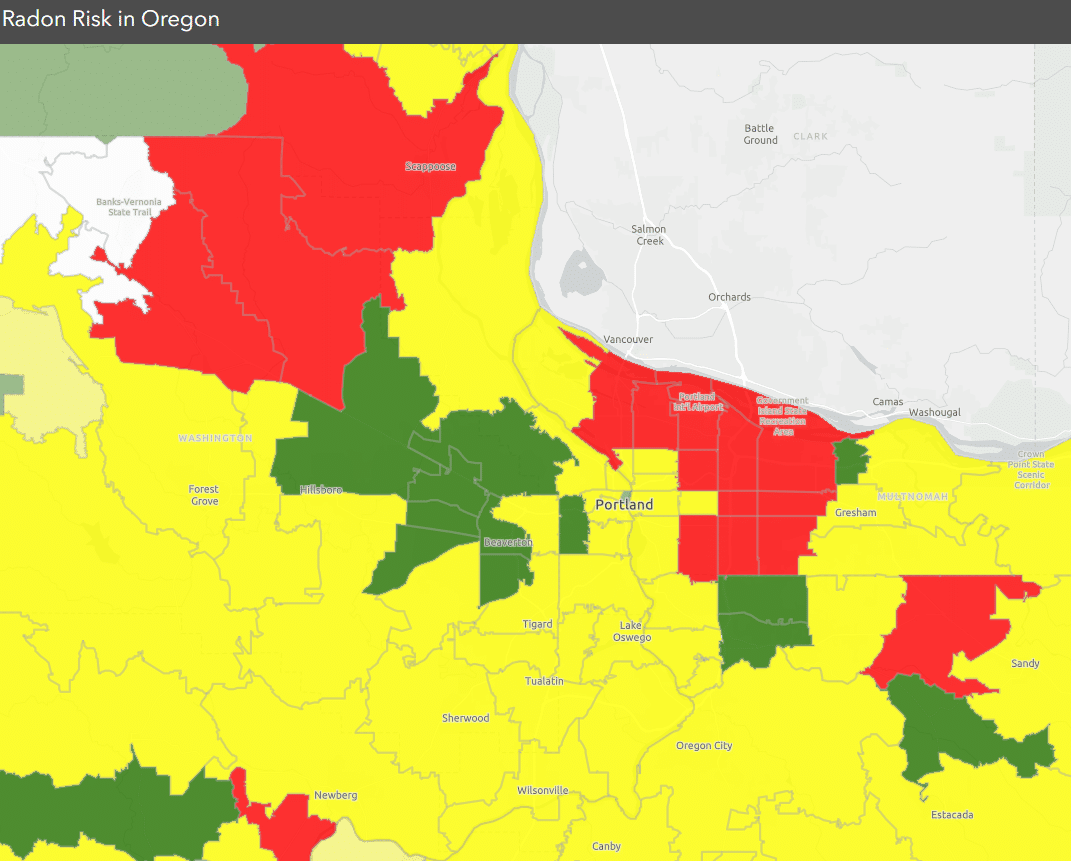Portland, Oregon Radon Map – Plus Free Tests (for some)

Portland, Oregon Radon rates change. A perennial hot topic in Portland is the influx of Californians, but it’s the Montana and Idaho migrants that we should be worried about, according to health officials.
Actually, they’re not talking about people, but rocks.
“In the Portland metropolitan area, a lot of the rocks and soil underneath the Willamette Valley were carried down from parts of Idaho and Montana,” said an Oregon Health Authority official quoted by OPB. These long-ago geological travelers carry radon, a radioactive gas that is drawn into homes and buildings, leading to cancer and other health issues.
As real estate agents, we do a lot of education about the risks of radon and the importance of testing, and after 2020, it’s more important than ever. People are spending more time in their homes, potentially increasing their radon exposure, and new public health data has uncovered even more risk areas in Oregon. In addition, more research on short-term tests shows that they are not nearly as effective as long-term tests, meaning that the radon test you received when you bought your home is good, but to be completely safe, you might want to do more (more on that in the last section of this article).
According to the Oregon Health Authority’s Radon Risk Map, a large area of Portland, including all of Northeast Portland, is at a high risk for radon exposure. (Updated 12/2023).

Click the radon map to access.
What Is Radon?
Radon is an odorless, colorless radioactive gas produced when radioactive materials in rocks and soil break down over time. Since it is odorless and colorless, the only way to know if there is radon in your home is to do a test. Radon is released constantly in the outside world, however, since it dispurses easily outside, it’s less of a health concern. It’s when radon becomes trapped in homes and buildings that the danger starts to happen.
Radon can enter homes through the foundation, well water, and other avenues. Once the radon gas enters the home, it remains trapped, increasing the amount of radon present. Radon is measured in picocuries per liter (pCi L). While no radon exposure is deemed a safe amount, meaning any amount of radon can be dangerous, the flag for high levels of radon in the home is 4 pCi L.
The danger from radon comes as the gas decays. It can attach itself to dust particles, which can then be breathed, as well as small amounts of the gas when breathing normal air. If a home has high amounts of radon, breathing it in consistently can lead to long-term problems. As the radon decays, it produces radiation every step of the process, posing more danger to those present.
Dangers of Radon
The primary danger for being in the presence of radon is lung cancer. It is estimated that radon accounts for the second largest percentage of lung cancer cases behind smoking. Smokers who come into contact with radon are at a higher risk of developing lung cancer as well.
To put the risks into perspective, an average of 120,000 people get diagnosed with lung cancer as a result of smoking in the United States per year. Radon, on the other hand, is responsible for an estimated 21,000 lung cancer cases yearly. While these numbers are far apart, they point to a noticeable trend.
Depending on the amount of radon in your home or business, smokers could be at a higher risk of getting lung cancer. For example, exposure to just 4 pCi/L of radon over the course of a lifetime could result in 62 out of 1,000 smokers getting lung cancer. This number drops to much lower for non-smokers: only 7 out of 1,000 people exposed to those levels of radon would develop cancer. This puts the percentages into perspective, showing just how dangerous radon exposure can be. It’s worth noting that lung cancer is one of the hardest cancers to treat, leading to poor prognosis for those diagnosed.
Radon Risk Levels – What Do They Mean?
Looking at Portland, we see a lot of red (high risk), more yellow (moderate), and some green (low risk). Scientists didn’t have to dig any holes to find where the radon-containing rocks were hiding because radon migrates upwards — into homes and buildings and through foundations and walls. So, risk levels are assigned to areas based on tests that check for these invisible, radioactive particles.
For each zip code in the state where an adequate number of test results are available, the Oregon Health Authority makes an assessment based on the following four factors:
- The number of single-family homes with a test result
- The maximum test result value in the zip code area (Radon levels can vary widely from address to address, which is why all homes need to get their own test done and retest every two years)
- The average test result value for the area
- The percent of locations within the area that had a test result of more than 4 piC/L (Picocuries per Liter. A “curie” is a unit used to measure radioactivity, named after Marie Curie, the scientist who discovered radium)
According to the EPA, radon levels of 4 pCi/L create the same level of risk of dying from lung cancer as dying in a car accident — and that’s for non-smokers. If you smoke, the lung cancer risk at this level of radon exposure goes up to 5x the risk of a fatal car accident. Higher levels of radon create even more certainty that cancer will result.
Radon levels can be reduced by installing a home mitigation system, but according to Consumer Reports, most homeowners with high radon levels don’t get it down below 2 pCi/L. At this level, there’s still an elevated risk for lung cancer, but even in the outdoor air, there’s always some radon present. The EPA reports that the average US outdoor radon level is 0.4 pCi/L.
Free Radon Tests
Note: Some Oregon zip codes don’t have enough test results to be assigned a risk level; if you live in one of these zip codes OHA will send you a free test kit so that the data can go into future radon maps.
How Accurate Is the Portland Radon Map?
Over time, as the Oregon Health Authority gathers more data from home test kits for radon, they can improve their risk level assignments. 2020 was a breakthrough year, showing more results than ever before. Fortunately, public awareness about the health hazards of radon is growing, and more homeowners are performing tests and applying mitigation strategies. Over time, however, this could skew the risk level assessment—a large number of homes that mitigate radon will show up as “low” radon homes.
Overall, we don’t recommend that Portland homeowners rely on the map alone to assess their radon risk. For one, it’s not a great map—sorry, OHA! It’s meant to provide an overview of radon risk statewide, and it doesn’t get more accurate as you zoom in (in fact, it doesn’t even show the street names bordering the risk areas).
Fortunately, you can get a breakdown of the risk levels of individual zip codes, whether in Portland or elsewhere in Oregon, by going to the OHA’s test results summary table. Here, you can easily look up your zip code and find out whether it’s red, yellow, or green.
Check the Radon Map, then Test (Even for “Green” Zones)
Because radioactive rocks can be anywhere, every home should have a radon test performed, even the home’s zip code is “green.” However, Oregon law does not require radon testing as part of the home sale inspection. That means it’s up to buyers to request the test as part of the home inspection. However, there are some important things to know before you test:
- Radon levels can fluctuate, so it’s best to test in winter.
- New research shows that the most accurate radon tests are long-term: 90 days or more. The best practice for home buyers is to get a 48-hour test done as part of the home inspection, then retest using a longer-term test the following winter before undertaking mitigation (or considering yourself safe!)
- Repeat the radon test every two years. The definition of a radioactive material is that it is unstable—radon-containing rocks may fluctuate in the amount of radon they release.
- New homes built in Portland (in fact, a wider area: all of Baker, Clackamas, Hood River, Multnomah, Polk, Washington, and Yamhill counties) since 2013 are required to use Radon Resistant New Construction. However, OHA still recommends that new homes be tested for radon.
Visit the Oregon Health Authority website for more information about testing your Portland home for radon, radon health risks, and mitigation. Questions about home inspections and making sure a home is safe before you buy?
Work with a Local Expert
Our top 1% buyers agents always recommend a radon test as part of the home inspection process (among other risks we highlight on this website). It is always better to be safe than sorry and the tests themselves are not expensive.
Our team has been helping home sellers and buyers for more than 20 years. Let us put our experience to work for you. Give us a call today at 503-714-1111 or chat with the bot on this site. We look forward to connecting!


